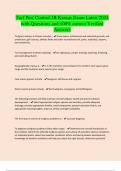Turf Pest Control 3B Kansas Exam Latest 2024
with Questions and 100% correct Verified
Answers
Turfgrass industry in Kansas includes: - ✔home lawns, institutional and industrial grounds, sod
production, golf courses, athletic fields and other recreational turf, parks, roadsides, airports,
and cemeteries.
Turf management involves selecting: - ✔the right grass, proper mowing, watering, fertilizing,
and controlling thatch.
Geographically, Kansas is - ✔is in the transition zone between the northern cool-season grass
range and the southern warm-season grass range.
Cool season grasses include - ✔bluegrass, tall fescue and ryegrass
Warm season grasses include - ✔bermudagrass, zoysiagrass and buffalograss
The following practices will help maintain overall turfgrass health and prevent disease
development. - ✔Select appropriate turfgass species and varieties, provide adequate
drainage, provide appropriate fertility, avoid compaction, prevent excessive thatch, use
appropriate mowing heights, improve airflow and light availability
The first step in control of turfgrass problems is - ✔accurate diagnosis
To diagnose turfgrass problems follow these steps: - ✔Determine the overall distribution of
the problem, identify the affected turfgrass species and cultivar (if possible), observe symptoms
on individual plants, determine weather conditions before and during disease development,
knowledge of weather conditions will help you select the right disease, determine potential
,problems with soil structure or fertility, determine the history of cultural practices at the site,
review pesticide management practices, use reference materials
Common turfgrass diseases in Kansas include: - ✔brown patch, dollar spot, fairy ring, large
patch of zoysiagrass, lef spot and melting out, necrotic ringspot, pin snow mold/microdochium
patch, powdery mildew, plythium foliar blight, rusts, spring dead spot, slime molds, andsummer
patch
Brown Patch - ✔Rhizoctonia salami most common and important disease of tall fescue in
Kansas
Brown patch is a - ✔Summer disease
Brown patch is more severe on - ✔Turf grasses under high nitrogen fertilization
Brown patch initially is - ✔Purple-green but quickly fades to light brown
Management of brown patch includes: - ✔Not fertilizing when brown patch is active, avoid
seeding rates greater than recommended rates , do not irrigate in late afternoon or evening.
Dollar spot - ✔Sclerotina hooeocarpa occurs on all turf grasses grown in Kansa
Dollar spot symptoms - ✔Small roughly circular bleached patches. 2-6" diameter in lawn turf
grass. 1-2" on putting greens
Management of dollar spot includes - ✔Adequate fertilization program a severe damage is
prevalent in nitrogen deficient turf
Fairy ring is caused by: - ✔Fungi in group of basidiomycetes and can occur in all species of turf
,Fairy ring fungi grow in the soil or thatch consuming organic matter and affect turf grass growth
-✔
In fairy ring after rain or heavy watering - ✔Fungal fruiting structures (mushrooms or
puffballs) May appear in the ring area. In addition whit spongy fungal growth maybe visible in
the thatch or soil underneath the ring
Fairy ring symptoms include - ✔Three categories.
Type 1 fairy rings - ✔Include turf death and are most common on sand based putting greens.
Has been associated with high salt content and hydrophobic conditions in the soil caused by
fungi
Type 2 Fairy ring - ✔Display a ring of lunch dark green turf and May or may not have fungal
fruiting structures
Type 3 fairy ring - ✔Develop a ring of fruiting bodies with no visible effect on the turfgrass.
May range in diameter from a few inches to 50 feet or more and they can expand overtime.
Fairy ring management includes - ✔No management needed as they symptoms are temporary
.
Leaf spot and melting out is caused by - ✔Several different fungi. Most common on Kentucky
blue grass and tall fescue
Nutrient Deficiency - ✔Areas or all of the turf may become yellowed and stunted. Chlorosis
(yellowing) is usually caused by nitrogen deficiency or iron deficiency.
, Buried Debris - ✔A thin layer of soil over buried rocks, lumber, bricks, plaster, or concrete
dries out rapidly in dry summer weather and may resemble disease.
compacted areas - ✔Thin turf or bare spots appear in heavily used areas. Waterlogged and
heavy-textured (clay) soils become compacted especially in areas with frequent foot or vehicle
traffic
Algae - ✔A green to blackish algae slime may form on bare soil or thinned turf in low, wet,
shaded or heavily used and compacted areas. The slimy mass of algae dries to form a thin, black
crust that later cracks and peels.
Moss - ✔Like algae, moss occurs where turfgrass has been thinned due to one or more site or
environmental factors.
Animal Urine injury - ✔Injury from dog or other animal urine may resemble brown patch or
dollar spot.
Thatch - ✔Thatch is a tightly intermingled layer of decomposing stems and roots that develops
between green vegetation and the soil surface.
To plan a good weed control program, you must: - ✔identify the desirable turfgrass,
•
identify the existing weeds, and
•
combine pest control with good management practices.
annual weeds complete their life cycle in: - ✔less than one year
Examples of summer annual weeds common to turfgrass: - ✔broadleaf weeds, knotweed,
spurge, purslane, (grass weeds) crabgrass, goosegrass, barnyardgrass, foxtail




